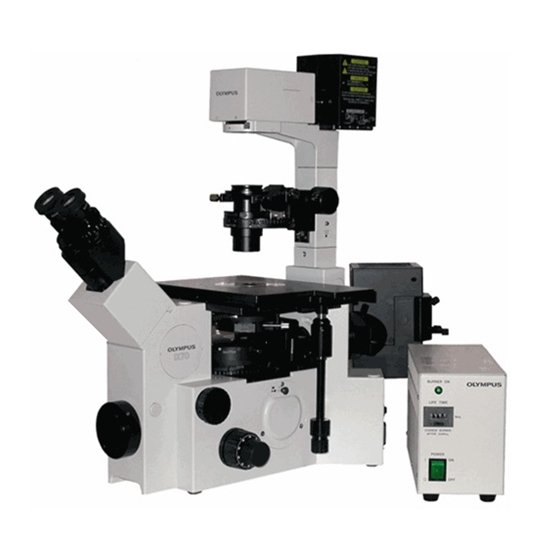Olympus IX70 Panduan Pengoperasian - Halaman 12
Jelajahi secara online atau unduh pdf Panduan Pengoperasian untuk Mikroskop Olympus IX70. Olympus IX70 32 halaman. Inverted fluorescent microscope
Juga untuk Olympus IX70: Petunjuk Pengoperasian (5 halaman)

useful here; the Full Chip buttons reverts to keeping the entire image. Do all of this setup in live mode.
Still too slow? 1) Shorten the exposure time; you can't run faster than the exposure. 2) Change the
binning to 2x2 or higher. This decreases the amount of data to pass (by reading 4 pixels vs one {for 2x2})
and also increases the sensitivity by a factor of 4 {for 2x2 case}. You need bright images to get enough
light during fast streams. 3) Change the choice of "shutter" in the Stream menu to NONE. This effectively
keeps the software from trying to operate the regular light shutter during imaging. There is a built in delay
to allow the shutter to open/close, and we are NOT using the Hg lamp for anything right now (laser path
is separate). 'Shutter' here means choice of illumination. You can be explicit (a TIRF setting), set as 'Use
Current Shutter', or pick 'None'.
Finally hit the acquire button on the lower right. You can abort a stream acquisition by pressing
and holding the ESC key. Once you acquire a stream, there will be a pause while the software writes data
from some buffer to another buffer. Grab another or save at this point. If you save the stack, it will take
some time to write it to disk, so decide whether to collect another stream or to take a pause while data gets
written. You have no choice but to save to disk if you've used up all the memory already.
Use the Acquire/AcquireTimelapse menu option (top menu bar) to generate a live image stream
and/or slow the data collection rate (i.e. collect an image every second/minute/ hour/etc.).
TIRF Shutdown:
The laser should be turned off by rotating the key to "off." The blower will stop automatically
when it's cool. Remove the key to prevent unauthorized operation (place on shelf). Be kind; return the
illumination selection slider to the mercury (Hg) position (UP).
Troubleshooting Guide:
If you cannot see the cell when you enter a shallow TIRF mode, it may mean that the cell is not
firmly attached to the glass interface. Find another cell to study.
If the sample is bleaching, decrease the laser power setting (trimpot) or add a ND filter to the
TIRF laser path (via slider). Dirty surfaces, water, air bubbles in the oil will result in strange illumination
patterns. If there is a problem, let us know and we will check the focus/alignment while you clean up your
prep.
No TIRF
beam. 1) Did you turn the laser key to START, not just ON? (is the yellow light on the
laser box on? Is there blue light in/around the laser tube?) 2) did you use the TIRF filter setting? (wrong
mirror cube in path?) 3) Is the TIRF beam path slide (behind scope) set down for laser? 4) Are you using
the 60x NA1.45 oil or 150x lens? Is the Oil OK? Is your dish leaking onto the objective? 5) Are cells on
a single coverslip?
...It was OK until I grabbed a stream or timelapse...
'none,' 'use current shutter,' or one of the TIRF settings.
Ugly image?
See the Fluorescence Troubleshooting (above) section regarding image display
options.
PDF Created with deskPDF PDF Writer - Trial :: http://www.docudesk.com
Check the "shutter" to make sure it's set to
12
